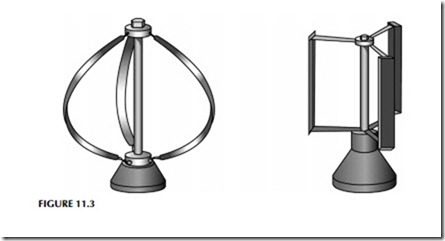WIND TURBINE TECHNOLOGY
The modern history of the wind turbine for power generation began during the oil crises of the 1970s. During these early years of wind development many different types of wind turbines were tested. The majority was horizontal-axis wind turbines with a rotor at one end of a shaft and a generator at the other, the whole mounted on the top of a high tower (Figure 11.2). Machines of this
type were fitted with rotors carrying one, two, three, and more blades. They could be upwind designs, with the rotor facing into the wind and the generator behind, or downwind designs that reversed this arrangement. All used gear- boxes to match the rotor speed to generator speed and they often relied on the grid for frequency synchronization and control.
Alongside these horizontal-axis turbines a range of vertical-axis turbines were also developed (Figure 11.3). The most common of these was the Darrieus or eggbeater wind turbine, so-called because its blades were shaped like those of an eggbeater. Other blade designs tested included an H-shaped vertical-axis configuration. The primary advantages claimed for vertical-axis turbines was that they do not need to yaw to keep the rotor facing into the wind while their massive mechanical components—the gearbox and the generator—can be sited on the ground.
In spite of these advantages, vertical-axis machines have never prospered. As the technology has matured most of these designs have disappeared so that today virtually all wind turbines have a similar configuration: a three-blade rotor attached to the front of a horizontal-axis drive-train shaft in an upwind design in which the rotor is always facing the wind. A generator and gearbox (if used) make up the remainder of the drive train that is housed in a protective nacelle mounted on top of a tall steel tower. From an average turbine size of 30 kW in the early 1980s, today’s largest onshore machines are in the 2–3 MW range, while offshore machines of 5 MW are now common, and larger machines up to 15 MW are being planned.
Alongside the market for utility wind turbines there is also a parallel market for smaller wind turbines of less than 100 kW. These are often used to supply power to remote sites, for off-grid domestic supply or for a range of small distributed generation applications. One of the largest markets for such small turbines is the United States.

